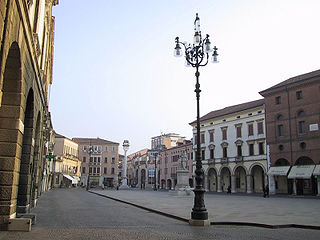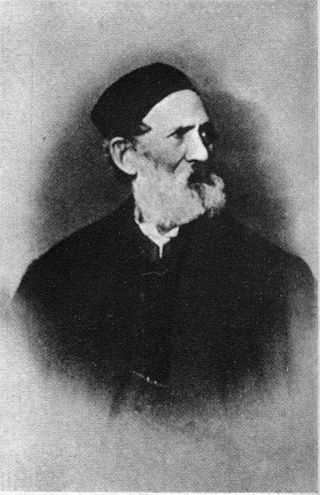Related Research Articles

Jacopo della Quercia, also known as Jacopo di Pietro d'Agnolo di Guarnieri, was an Italian sculptor of the Renaissance, a contemporary of Brunelleschi, Ghiberti and Donatello. He is considered a precursor of Michelangelo.

The Basilica di Santa Maria Gloriosa dei Frari, commonly abbreviated to the Frari, is a church located in the Campo dei Frari at the heart of the San Polo district of Venice, Italy. It is the largest church in the city and it has the status of a minor basilica. The church is dedicated to the Assumption of Mary.

Rovigo is a city and commune in the region of Veneto, Northeast Italy, the capital of the eponymous province.

Ca' Rezzonico is a palazzo and art museum on the Grand Canal in the Dorsoduro sestiere of Venice, Italy. It is a particularly notable example of the 18th century Venetian baroque and rococo architecture and interior decoration, and displays paintings by the leading Venetian painters of the period, including Francesco Guardi and Giambattista Tiepolo. It is a public museum dedicated to 18th-century Venice and one of the 11 venues managed by the Fondazione Musei Civici di Venezia.

Girolamo Da Carpi was an Italian painter and decorator who worked at the Court of the House of Este in Ferrara. He began painting in Ferrara, by report apprenticing to Benvenuto Tisi ; but by age 20, he had moved to Bologna, and is considered a figure of Early Renaissance painting of the local Bolognese School.

San Bartolomeo is a church in Venice, Italy. It is near the Rialto Bridge in the sestiere (district) of San Marco.

Sant'Anna dei Lombardi,, and also known as Santa Maria di Monte Oliveto, is an ancient church and convent located in piazza Monteoliveto in central Naples, Italy. Across Monteoliveto street from the Fountain in the square is the Renaissance palace of Orsini di Gravina.

Santi Prunati was an Italian painter of the Baroque era, born and mainly active in Verona.
Giuseppe Antonio Ghedini was an Italian painter of the Baroque period, mainly active in Ferrara.
The decade of the 1490s in art involved some significant events.
The decade of the 1480s in art involved some significant events.

San Francesco della Vigna is a Roman Catholic church in the Sestiere of Castello in Venice, northern Italy.

Antonio Randa was an Italian painter of the classicist period, active in Ferrara, Modena, Rovigo, Florence, Comacchio and his native Bologna.

Santa Maria dei Carmini, also called Santa Maria del Carmelo and commonly known simply as the Carmini, is a large Roman Catholic church in the sestiere, or neighbourhood, of Dorsoduro in Venice, northern Italy. It nestles against the former Scuola Grande di Santa Maria del Carmelo, also known as the Scuola dei Carmini. This charitable confraternity was officially founded in 1597, and arose from a lay women's charitable association, the Pinzocchere dei Carmini. The members of this lay group were associated as tertiaries to the neighbouring Carmelite monastery. They were responsible for stitching the scapulars for the Carmelites.

San Procolo is an early Gothic-style, Roman Catholic church and former monastery-hospital located on Via Massimo D'Azeglio #52 in central Bologna, region of Emilia Romagna, Italy.
Luigi Antonio Boscolo was an Italian engraver, active in Venice and Rovigo.

Adeodato Malatesta was an Italian painter, trained in a grand Neoclassical style, depicting mostly of sacred and historic subjects.

The Church of Santa Sofia is a Roman Catholic church in the city of Lendinara, in the Province of Rovigo, region of Veneto, Italy.
AntonioGaidon (1738–1829), was an architect, urban planner and naturalist.
References
- ↑ Catalogo dei beni artistici e storici, Rovigo: le chiese. By Vittorio Sgarbi (1988)
- ↑
- Bartoli, Francesco (1793). Le pitture, sculture ed architetture della città di Rovigo: con indici ed illustrazioni. Googlebooks. Pietro Savoni, Venice. p. 322.
- ↑ Official Website of the Academy.
- ↑ Entry by Elena Bassi on the Baseggio family in the encyclopedia Treccani.